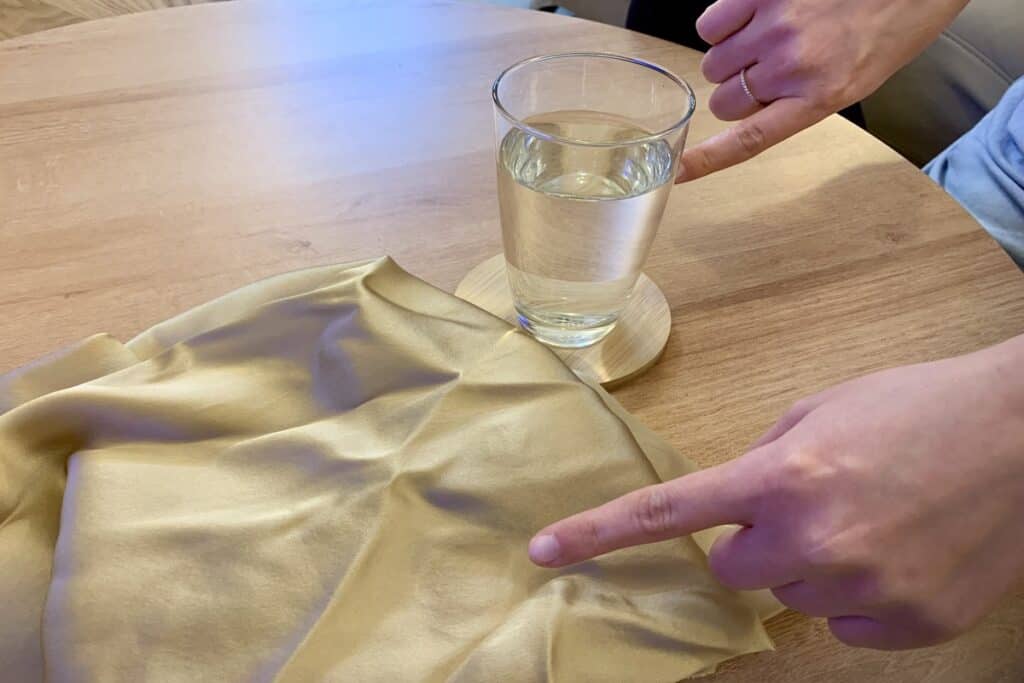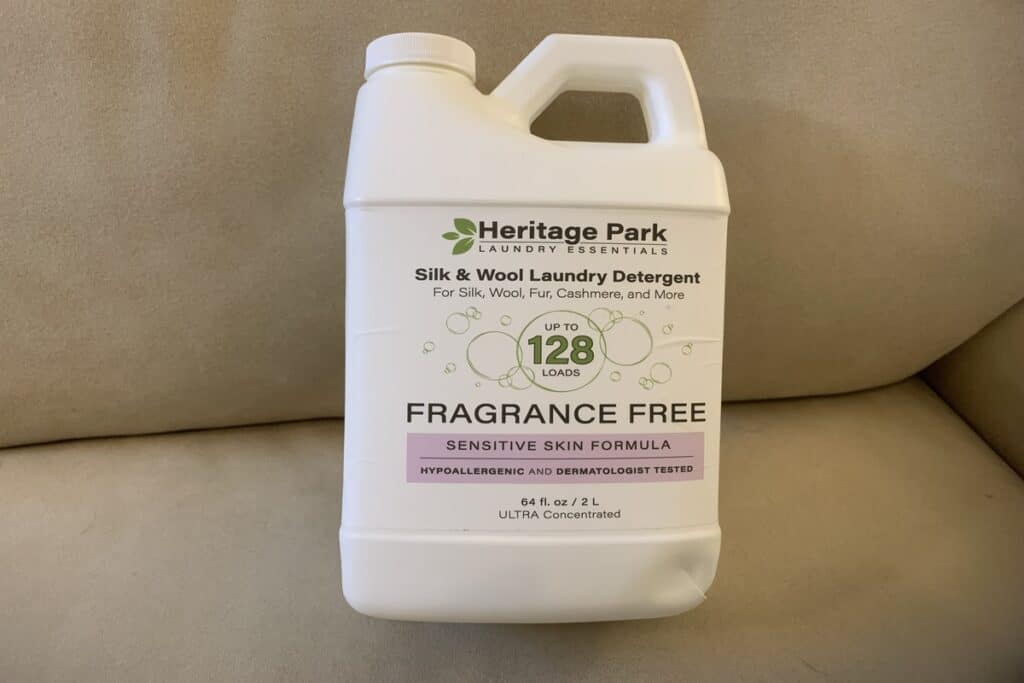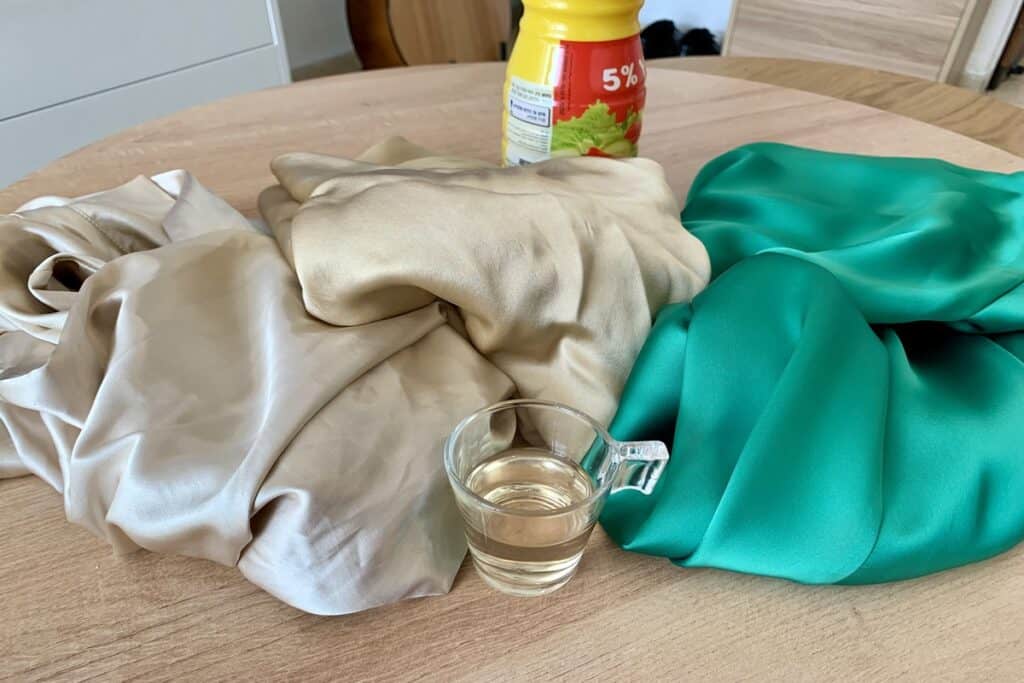Silk and Water: Everything You Actually Need to Know
Silk has a complex molecular structure that makes it react uniquely when it comes into contact with water.
Unlike wool or cotton, silk fibers can undergo chemical changes with exposure to water that damage the fibers.
Knowing what kinds of changes occur, and how to either prevent or reverse those changes, is key to keeping silks in good condition over the long term.
In this article, I’ll explore the science behind silk’s reaction to water and offer plenty of practical advice for real-life situations involving water and silk.
My goal is to equip you with the knowledge to handle silk confidently day-to-day, wash it effectively, and restore it if accidents happen. Let’s dive in!

How Water Affects Silk Fibers
To understand why water can be silk’s worst enemy, it helps to first look at the physical structure and chemical composition of silk on a molecular level.
The Chemical Structure of Silk
Silk fibers are made up of a protein called fibroin, which contains tightly packed crystalline regions and amorphous regions.
The amino acids in these regions give silk special properties, like strength and elasticity.
Water molecules interact with the proteins in silk, causing physical and chemical changes:
- Physical changes: Water swells the amorphous regions and causes the fibers to expand. This enlarges the spaces between fibers.
- Chemical changes: The proteins can unfold and break apart, damaging the crystalline regions that give silk its strength.
How This Affects Silk’s Properties
Water exposure affects silk in three key ways:
- Tensile strength – Silk’s strength comes from the crystalline regions. When water damages these, silk becomes weaker and more prone to rips and tears.
- Elasticity – The amorphous regions give silk its elasticity. When water swells these regions, silk can lose its ability to bounce back into shape.
- Appearance – Water causes changes to the fiber surface, making silk dull, stiff, and brittle over time.
My article explains the safety and risks of soaking silk in detail.

Too much water too often can lead to irreversible damage. But with proper care, water-related damage can be minimized.
Getting Rid of Water Stains on Silk
Water doesn’t just weaken silk – it can also leave unsightly stains if not dealt with promptly. Here’s what you need to know about water stains on silk and how to remove them.
The Causes of Water Stains
Water stains on silk come from:
- Dyes or other residues dissolved in the water and absorbed by silk. Common examples are coffee, tea, and sweat.
- Minerals in hard water leave behind deposits on silk as the water evaporates.
- Oils from the skin also evaporate and leave residue.

The stain appears as a discolored ring. The longer the stain sits, the harder it is to remove.
Removing Stains from Silk
For light stains:
- Blot with clean water and a paper towel immediately. Don’t rub.
- Once blotted, sprinkle borax on the stain and let sit for 5-10 minutes.
- Rinse the borax out with lukewarm water. Repeat if needed.


For set-in stains:
- Mix a solution of lukewarm water and silk-specific detergent.
- Apply to stain with a soft cloth. Let sit for 10-30 minutes.
- Blot stain, don’t rub.
- Rinse with clean lukewarm water.
I swear by Heritage Park Laundry Detergent (link to Amazon) for all my silk garments. It’s gentle, effective, and leaves the silk feeling wonderfully smooth and looking vibrant.

Preventing Water Stains
You can prevent many stains by:
- Blotting spills right away with an absorbent cloth, don’t rub.
- Using coatings like Scotchgard to make silk more water resistant.
- Hand-washing periodically to remove residues before they build up.
- Storing silk in breathable, acid-free tissue paper versus plastic.
Step-by-Step Guide to Washing Silk
While daily wear and tear may make washing necessary, laundry day strikes fear into the hearts of silk lovers everywhere.
Follow these do’s and don’ts to keep your silk looking fresh:
Do: Check the Item’s Washability
- Read garment labels – Symbols like “Dry Clean Only” are there for a reason!
- Identify fabric content – Some garments may be silk blends, with more washable fibers mixed in.
- Assess construction – Delicate decorative details may require professional cleaning.
When in doubt, take it to the dry cleaner.

Do: Hand Wash Using Gentle Cleansers
For washable silks, hand washing is safest. Steps include:
- Fill a sink or tub with lukewarm water and dissolve a small amount of silk-specific detergent.
- Submerge the item gently. Allow to soak for 3-5 minutes.
- Agitate very delicately by hand, don’t wring, twist, or scrub.
- Drain water and refill with clean lukewarm water. Rinse until the water runs clear.
- Lay flat on a non-absorbent surface to dry, or roll in a towel to blot water.
- Shape the garment back into form as it dries.






Don’t: Leave Silk Sitting Wet for Long
Prolonged soaking weakens silk’s fibers – limit soak time to 5 minutes max.
And never wring out silk or hang it to dry dripping wet – this stretches fibers permanently.
Learn about fabric care limits in my guide on how long silk can sit in water.
Don’t: Use Hot Water, Harsh Detergents, or Agitation
Stick to cool or tepid water, ideally below 77°F (25°C). Hot water damages silk proteins.
Use detergents labeled safe for silks. Avoid bleach and products with additives like scent or fabric softener.
Minimal hand agitation only – no washing machines, unless specifically designed for silks! The motion damages fibers.
Emergency Steps for Wet Silk
Accidents happen – silk can get caught in the rain, splashed at a party, sat on while wet at the pool. Here’s what to do when silk meets a surprise soaking:
Step 1: Blot Excess Moisture ASAP
Don’t wipe or rub wet silk. Gently press with clean rags or paper towels to absorb pooling moisture.

Step 2: Lay Flat to Air Dry
Unravel tangled or bunched-up areas. Shape the garment back into its proper form before leaving it to dry fully.
Step 3: Do a Water Rinse Once Dry
Rinsing removes any residues left behind by rain or other water sources. Follow the directions above for hand washing.
For heavy exposure like falling in a pool, take it to the cleaners for professional treatment.

Beware Rainwear!
Not all rainwear protects silk equally. Consider:
- Umbrellas – Effective water shield, but wind can blow rain underneath.
- Raincoats – Work great, but watch for pooling moisture along coat edges.
- Hats – Help somewhat, but raindrops can still seep through hat brims.
Choose high-quality materials with seam sealing and storm flaps for the best protection.
Restoring Life to Damaged Silk
If silk has become damaged from water exposure, don’t panic! Here are some fixes:
| Issue | Solution |
| Loss of texture/drape | Use silicone-based fabric renewer sprays to add the body back. |
| Faded colors | Try re-dyeing using custom dye kits safe for silks. |
| Mildew smells | Gently wash using distilled white vinegar added to rinse water. |
| Holes/tears | Consult a textile specialist for invisible mending options. |
| Severe loss of strength | Silk overlays and linings can reinforce weakened areas. |
Repairing damage requires patience and a gentle approach. For heirlooms or expensive investment pieces, professional help may be needed.

Everyday Practical Tips for Keeping Silk Safe from Water
With some simple habits, you can prevent and minimize water damage in silk:
- Store silk folded inside breathable acid-free tissue, never plastic. Allow to air out before re-packing.
- Spot clean stains right away with absorbent cloth and distilled water.
- Limit sun exposure to avoid UV damage that makes silk more water-sensitive.
- Apply fabric protector sprays like Scotchgard to help the silk resist water. Re-apply after cleanings.
- Keep silk away from steam, sprinklers, pools, and other wet environments.
- Pack silk garments in waterproof layers for travel and storage. Use breathable silk garment bags.
- Hang the silk to dry fully before wearing it again. Don’t store damp silk.
- Learn silk’s care instructions when buying new items. Follow the washing directions carefully.
Remember, an ounce of prevention is worth a pound of cure when it comes to keeping silk away from water!
Handling Wet Situations with Care
How Do You Remove the Mildew Smell from Silk?
If silk has developed a mildew or musty smell from getting wet, you can try to remove it by gently washing the item by hand using a couple tablespoons of distilled white vinegar added during the rinse water step.
The vinegar will help kill mildew and refresh the silk. Be sure to fully air dry afterward. Severe mildew may require professional cleaning to remove the odor.

Can You Spot Clean Silk?
Yes, you can spot clean silk using a gentle approach. Mix a mild detergent with cool distilled water. Use a soft cloth to very lightly blot the spot, don’t rub.
Rinse by blotting with clean water and let air dry. Be careful not to create rings or watermarks on the silk when spot cleaning. Test any cleaners in an inconspicuous area first.
Conclusions
Silk has a delicate nature requiring gentle care when it meets water. But a little knowledge goes a long way in handling silk confidently and minimizing water damage.
Follow the practical tips outlined above for storing, washing, and restoring silk fabrics. Most importantly, catch spills quickly and allow silk time to fully dry after getting wet.
With some reasonable precautions, your silks will maintain their natural beauty and last for many years to come.
